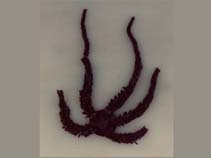Ophiocoma erinaceus Müller & Troschel, 1842
| Native range | All suitable habitat | Point map | Year 2050 |

|
| This map was computer-generated and has not yet been reviewed. |
| Ophiocoma erinaceus AquaMaps Data sources: GBIF OBIS |
Classification / Names Common names | Synonyms | CoL | ITIS | WoRMS
| Ophiacanthida | Ophiocomidae
Environment: milieu / climate zone / depth range / distribution range Ecologia
Associadas(os) a recifes; intervalo de profundidade 0 - 27 m (Ref. 81020). Tropical
Distribuição Países | Áreas FAO | Ecossistemas | Ocorrências | Introduções
Entire Indo-Pacific except for Pakistan, and western India.
Length at first maturity / Tamanho / Peso / Idade
Maturity: Lm ? range ? - ? cm Max length : 2.5 cm WD macho/indeterminado; (Ref. 800)
Disk diameter: 2.0 to 2.5 cm. Found in waters less than 30m, among rocks and boulders. Associated with coral communities. Hides beneath rocks and in reef cavities (Ref. 129602). Inhabits reef areas and can be found between the branches of live and dead corals or in rubble areas. Feeds on detritus.
Life cycle and mating behavior Maturidade | Reprodução | Desova | Ovos | Fecundidade | Larvas
Members of the class Ophiuroidea are mostly gonochoric, others are protandric. Fertilization is external. Brooding is common, bursae is used as brood chambers where the embryos develop into juveniles and later crawl out from the bursal slits. Life cycle: Embryos hatch into free-swimming planktotrophic larvae and later metamorphose into tiny brittle stars which sink down the bottom where they grow into adult form.
Referência principal
Referências | Coordenador | Colaboradores
Schoppe, S. 2000. (Ref. 800)
Status na Lista Vermelha da IUCN (Ref. 130435)
Status no CITES (Ref. 108899)
Not Evaluated
CMS (Ref. 116361)
Not Evaluated
Perigo para os humanos
Harmless
Uso pelos humanos
| FishSource |
Ferramentas
Mais informação
Idade/Tamanho
Crescimento
Comprimento-peso
Comprimento-comprimento
Morfologia
Larvas
Abundância
Crescimento
Comprimento-peso
Comprimento-comprimento
Morfologia
Larvas
Abundância
Fontes da internet
BHL | BOLD Systems | CISTI | DiscoverLife | FAO(Publication : search) | Fishipedia | GenBank (genoma, nucleotídeo) | GloBI | Gomexsi | Google Books | Google Scholar | Google | PubMed | Árvore da vida | Wikipedia (Ir para, procura) | Registro zoológico
Estimates based on models
Preferred temperature
(Ref. 115969): 24.8 - 29.3, mean 28 (based on 2190 cells).
Categoria de preço
(Ref. 80766):
Unknown.



